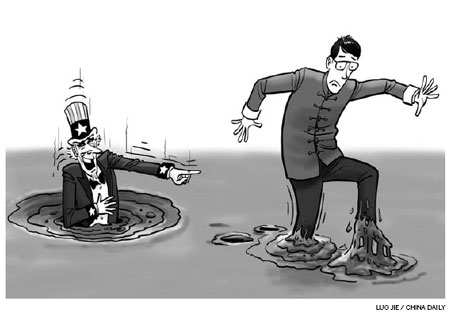Opinion
The China dilemma for US
Updated: 2011-08-18 11:13
By Handol Jones (China Daily)
|
 |
The continued strong growth of the Chinese economy is not guaranteed, but it is not in the best interest of the United States to expect China to fail. It is, however, important to understand some of the capabilities that are being built in China.
Many are blaming China for unemployment in the US, but this is avoiding the real problem - the US needs to build its own industries. There is also continued pressure for the revaluation of the yuan, which is, in effect, a weakening of the dollar and reduction of the buying power of the US consumer. The reality is that the yuan will rise, and the only factor is how fast Chinese goods will become more expensive for the American consumer.
A key part of China's strength is the building of a large industrial base, with many actions being taken by government agencies to support economic growth. The manufacturing base in China was initially in low-cost and lower-skill areas such as clothing and footwear, but currently it includes automobiles, iPhones and a range of high-complexity products.
China is building its expertise in precision manufacturing. For example, 44.6 percent of the 1.2 billion handsets sold globally in 2008 were manufactured in China - and last year the figure rose to 68.9 percent of the 1.4 billion handsets sold worldwide. Mobile handsets require high levels of manufacturing skill as well as strong supply chain capabilities.
China has become the manufacturing center of precision handsets. Though it is possible to move the manufacturing base to other countries, the strong supply chain infrastructure built in China will take many years to replicate in other countries.
China has built a 300-kilometer-an-hour elevated train track between Beijing and Shanghai, and plans to extend the high-speed tracks to 18,000 km by 2020. And although the accident in Wenzhou, Zhejiang province, showed some weaknesses in planning and monitoring in China, it is important not to overestimate the damage. China is in a hurry and is learning fast.
A good comparison would be the Bay Bridge from Oakland to San Francisco in the US, which is just 7 km long. It was started in 2003 and scheduled for completion in 2013. Not surprisingly, steel structures from China are being used in this bridge, for the US has lost some of its technology expertise in this area. China does not have the same level of thoroughness in managing highly sophisticated railroads as Japan, but it is strengthening its capabilities rapidly. China has acted on its high-speed trains while US activities are wired in local disputes.
China has a centrally managed economy, the general attitude in China is that as long as the economy grows rapidly, jobs are provided and wages increase, there is a willingness to conform. When accidents occur, such as the one in Wenzhou, there is a strong outcry and micro blogs are used extensively to spread complaints. But it is clearly not wise to bet against the Chinese industrial base remaining dominant in the next five to 10 years.
China has to evolve from providing inexpensive and large pools of labor to designing its own products. The transition to developing high-tech Chinese products is occurring in the automobile industry, and a key approach is to use joint ventures.
The building of fuel-efficient automobiles, high-speed trains and commercial aircraft requires extensive planning and building of a wide range of technologies, and there has been a migration from "open door" to "open gate".
But despite all this, China faces many challenges. Many of the entrepreneurs and officials are rapidly gaining wealth by building the manufacturing base and service industries, including those that are Internet-related. This occurred in the US, too, in the past. There is, however, increased income inequality in China and higher levels of conspicuous consumption. It is good to reward the contributors, but it is important that the "rising tide raises all boats". High inflation and local government debt need to be addressed, too.
The growth of China cannot be disputed, but the key issue is to understand what will happen in the future. With the reduction in the purchasing power of US and European consumers, China's exports can decline. That's why China needs to increase its internal consumption faster than exports decline.
The large import costs of coal, steel, oil, copper and other commodities must be covered with exports. China needs the US and Europe to remain relatively solvent while new markets are developed, even though it has limited power outside its borders.
China has been insular to outside factors in the past, but its present leaders are very attuned to the global environment and understand the penalties associated with underestimating foreigners. Chinese have not forgotten the abuse foreigners subjected China to for more than 150 years before 1949. Chinese are no longer insular to outside threats, and it's time Americans became more attuned to such threats and competition.
China faces many challenges, and it is likely that it will commit some mistakes. But its upward momentum will continue.
It is easy to find faults with China because it allows us to feel comfortable with our position. This, however, is a big mistake.
It is not astute to bet against China. Instead, it is important to learn from China and rebuild the manufacturing base in the US. To generate more employment, the US should build new industries in addition to future generations of employees that can work in these industries. The US can compete with China long term only if it makes major changes in its strategies.
It is important to track China carefully and regard it as a friend as well as competitor. Time, however, is the enemy.
The author is founder, owner and CEO of US-based International Business Strategies, Inc in Silicon Valley, California, and has Chinamerica: The Uneasy Partnership That Will Change The World, to his credit.

Specials

Biden Visits China
US Vice-President Joe Biden visits China August 17-22.

Star journalist leaves legacy
Li Xing, China Daily's assistant editor-in-chief and veteran columnist, died of a cerebral hemorrhage on Aug 7 in Washington DC, US.

Hot pots
Tea-making treasures catch the fancy of connoisseurs as record prices brew up interest